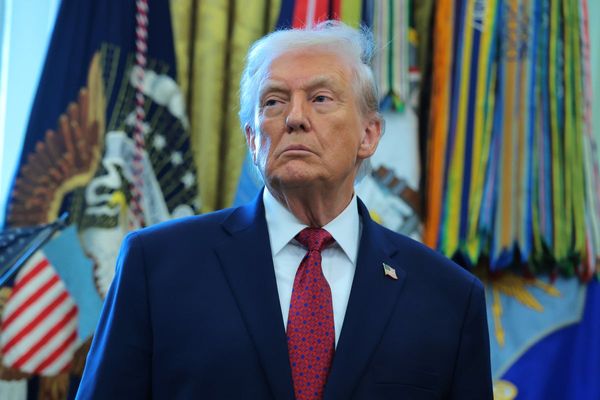
TikTok users have a well-known obsession with efforts to “de-puff” the face in the pursuit of a “snatched” jawline and to combat “face bloating” and “cortisol face”, which has already been debunked as not a medical term.
The latest trend going viral is “ear seeding” – a needle-free form of acupuncture applying beads (often secured in place by adhesive) to stimulate pressure points in the ear that are supposed to target different body parts.
As one influencer, who has more than 5 million followers on the platform, presses the seeds into her ear she tells her followers “this point really hurts”. She then directs them to “look at my jawline here” – pointing to the side where she has applied the seeds before turning her head so as to create a double chin on the other side, her voice noticeably lower with the strain – “versus here”.
She is not alone, as many others also claim to see a difference. “I just watched the before and after and it’s definitely worked!” another influencer tells her followers.
But what do the experts say about this trend?
What is ear seeding and where does it come from?
Lily Feng, an acupuncturist and the director of the Australian Acupuncture and Chinese Medicine Association, says ear seeding is a form of traditional Chinese medicine. Auricular acupuncture or auricular acupressure uses filiform needles, dermal needles, metal seeds or Semen vaccariae seeds to apply physical pressure to stimulate auricular points. These points are supposed to correlate with body parts – based on the association between the ear’s shape and an inverted foetus – so stimulating the corresponding point of the ear can help achieve a therapeutic outcome elsewhere on the body, Feng says. “But it does not relate to cosmetic claims made online.”
Prof Jon Wardle, the director of the national centre for naturopathic medicine at Southern Cross University, says the trend co-opts traditional Chinese medicine. The difference is that “people are bypassing the practitioners and the expertise and recommending uses that may or may not be useful”.
Many influencers promote ear seeds customers can apply themselves at home. The trend’s popularity has led to beauty brands including Mecca offering gold ear seed therapy sessions with an acupuncturist – to add a “‘feel-good sparkle’ to your wellness path”.
What does the evidence show?
Dr Theone Papps, a dermatologist at the Skin hospital in Sydney, says there have been some randomised controlled trials where one group have ear seeding and another placebo group have tape and no seed, or nothing at all.
A lot of these research studies come from China and Korea. The assumption is that ear seeding – like acupuncture – may trigger nerve reflexes, which may then release muscle tension, Papps says.
Most of the studies have been conducted on patients who have had surgery, she says – often jaw or dental surgery. “Many of these studies are positive in that they show that there is improvement in pain and anxiety … but there’s not enough robust research with regards to facial de-puffing.”
Associate Prof Deshan Sebaratnam, another dermatologist at the Skin hospital, says there is no evidence to support that ear seeds can sculpt or lift the face, nor evidence that pressing on an ear can help with respiratory, digestive or endocrine issues, as is sometimes claimed in ear seed marketing.
Are there any harms from ear seeding?
Papps says considers ear seeds a “low-risk treatment” but cautions that excessive repeated pressure could cause trauma to the cartilage. If the tape is left on too long it could can dryness or irritation to the skin. To people who want to use ear seeds, she advises avoiding excessive pressure when applying them and maintaining hygiene.
Wardle agrees that the therapy in itself is not harmful but harm could come if people used it to address symptoms related to an underlying medical issue, ignoring other treatments.
The regulations for unregistered health practitioners require them to avoid monopolising the care of a patient and not discourage multidisciplinary care where appropriate, he says.
Are there reasons to be worried about a puffy face?
Facial puffing can be serious if it is due to underlying medical conditions, Papps says, such as thyroid malfunction, kidney problems that cause fluid retention or hormonal changes, as well as dermatological issues including cutaneous sarcoidosis and skin lymphoma.
“If it’s persistent and not responding to some simple measures, it is, of course, always important to have a review with a medical professional to make sure anything serious is excluded,” she says.
But “a lot of people wake up quite puffy in the morning, and a lot of that’s just gravity and poor lymphatic flow”, she says. “The lymphatics drain all of our toxins – it’s basically the plumbing system to eliminate a lot of the junk that’s in our body.”
If someone has ruled out any other serious causes of facial puffiness, Papps recommends trying simple solutions like elevation – sleeping on a few extra pillows. Facial massage can also promote circulation.
Sebaratnam says: “Most people do not need to do anything extra to help clear their lymphatics – your body does this naturally.” But in certain situations, he said, for instance for patients who have had their lymph nodes removed because of cancer surgery, some people find that massage can be helpful.
• Natasha May is Guardian Australia’s health reporter
• Antiviral is a fortnightly column that interrogates the evidence behind the health headlines and factchecks popular wellness claims







